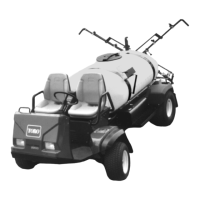5
SAFETY INSTRUCTIONS
A. Use extreme caution, reduce speed
and maintain a safe distance around sand
traps, ditches, creeks, ramps, and any
unfamiliar areas, or other hazards.
B. Watch for holes or other hidden
hazards.
C. Always reduce speed before starting
up or down a hill. Do not start or stop
suddenly when traveling uphill or downhill.
Use caution when operating vehicle on a
steep slope. Normally travel straight up and
down slopes. Avoid turning on hillsides
whenever possible. Reduce speed when
making sharp turns or when turning on
hillsides.
D. If engine stalls or loses power and
cannot make it to the top of a slope, do not
turn vehicle around. Always back slowly
straight down the slope.
E. Use extra caution when operating
vehicle on wet surfaces, at higher speeds
or with a full load. Stopping time will
increase with a full load.
F. Operate vehicle with extra caution
when handling off-center loads that cannot
be centered.
G. Avoid sudden starts and stops. Do not
go from reverse to forward or forward to
reverse without first coming to a complete
stop.
H. Do not attempt sharp turns or abrupt
maneuvers or other unsafe driving actions
that may cause a loss of vehicle control.
I. Before backing up, be sure no one is
behind the vehicle. Back up slowly.
J. Watch out for traffic when near or
crossing roads. Always yield the right of
way to pedestrians and other vehicles. This
vehicle is not designed for use on streets
or highways. Always signal your turns and
stop early enough to let other people know
what you plan to do. Obey all traffic rules
and regulations.
K. Never operate vehicle in or near an
area where dust or fumes which are
explosive, are in the air. The electrical and
exhaust systems of the vehicle can produce
sparks capable of igniting explosive
materials.
L. Watch out for and avoid low overhangs
such as tree limbs, door jambs, overhead
walkways, etc. Make sure there is enough
room overhead to easily clear the vehicle
and your head.
M. If ever unsure about safe operation,
STOP WORK and ask your supervisor.
18. Operator and passenger must be skilled and
trained in how to drive on hillsides. Failure to use
caution on slopes or hills may cause loss of control
and vehicle to tip or roll, possibly resulting in
personal injury or death.
19. Using the vehicle demands attention. Failure
to operate vehicle safely may result in an accident,
tip over of vehicle and serious injury or death.
Drive carefully. To prevent tipping or loss of
control:
A. Engage the Parking Brake.
B. Make sure Traction Pedal is in
NEUTRAL. Move the Throttle Lever to 1/4
to 1/3 throttle.
C. After engine is started, release parking
brake and keep foot off traction pedal. The
vehicle must not move. If movement is
evident, the neutral return mechanism is
adjusted incorrectly. Shut engine off and
refer to the Traction Drive Maintenance
section on pages 43 and 44.
WHILE OPERATING
WARNING: Do not run engine in a confined
area without adequate ventilation. Exhaust
fumes are hazardous and could possibly be
deadly.
15. Operator and passenger should remain
seated whenever the vehicle is in motion. Operator
should keep both hands on steering wheel
whenever possible, and passenger should use
hand holds provided. Keep arms and legs within
the vehicle body at all times. Remember your
passenger may not be expecting you to brake or
turn and may not be ready.
16. Sit on seat when starting and operating the
vehicle.
17. When starting the engine:

